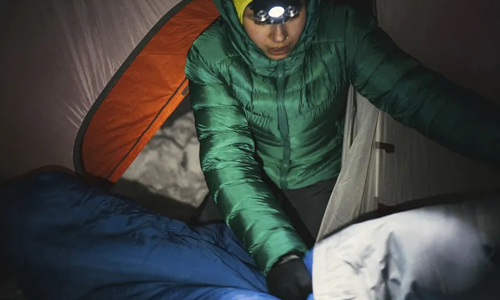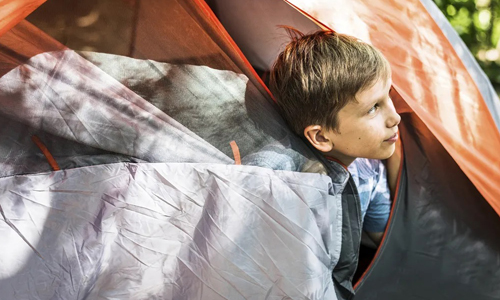Preventing Condensation Inside Your Tent: Tips for a Dry and Comfortable Camping Experience
Author
Camping in a cosy tent amidst nature's beauty is an enriching experience, but condensation can turn it into an uncomfortable and damp affair. When warm air inside the tent meets a cold surface like a rainfly, condensation occurs, leading to soggy sleeping quarters. To combat this issue, implementing three key strategies can make a significant difference in keeping your tent dry and enjoyable during your camping trips.
Minimise Moisture Sources Inside Your Tent
Condensation inside the tent can originate from three sources: the existing humidity in the air, moisture from your breath while sleeping, and any wet items stored inside. Although you cannot control the ambient humidity or stop breathing, you can manage the moisture from wet belongings. Avoid keeping wet clothes or gear inside the tent; instead, dry them during the day to prevent excess moisture buildup inside the tent.

Prioritise Proper Ventilation
A well-ventilated tent is essential in reducing condensation. Focus on these ventilation practices:
- Position the tent door to face a gentle breeze, if possible, to facilitate air circulation.
- Ensure the tent is staked out tightly and the rainfly is well-tensioned, creating ample airspace between the rainfly and tent walls.
- Open all rainfly doors and roll-up sections to maximise airflow; only close them if it starts raining.
- Utilise all available rainfly vents, especially those situated in opposite directions to encourage cross ventilation.
- Open all inner tent windows to allow fresh air to circulate throughout the interior.
By following these ventilation techniques, you replace the humid interior air with drier outside air, reducing the chances of condensation buildup.

Choose an Optimal Tent Location
Picking the right spot to pitch your tent can play a crucial role in reducing condensation. Opt for locations under trees, as the air underneath them tends to be warmer compared to open fields. This choice results in a warmer rainfly, making it less susceptible to condensation. Additionally, trees deflect condensation from forming on the tent's surface, keeping the interior drier.
Conclusion
Preventing condensation inside your tent can significantly enhance your camping experience. Selecting an optimal location, minimising internal moisture sources, and ensuring proper ventilation are the three key strategies to combat condensation effectively. Embrace these practices, and you'll wake up to a more pleasant, dry, and comfortable camping environment, ready to embark on your next adventure with a smile.
Author
Categories
- Sport (28)
- Product Reviews (3)
- Team Outdoor Look (7)
- Mike Wild (2)
- Mike Payton (2)
- Suse Hammond-Pears (3)
- Snowboarding (12)
- Latest Offers (105)
- Shop Talk (1)
- Competitions (7)
- Walking (413)
- Lifestyle Fashion (8)
- Travel (86)
- Kit Guides (176)
- Workwear Clothing (6)
- Safety Workwear (4)
- Health/Fitness (289)
- Skiing (91)
- Great Outdoors (1316)
- Cycling (92)
- January 2025
- December 2024
- November 2024
- October 2024
- September 2024
- August 2024
- July 2024
- June 2024
- May 2024
- April 2024
- March 2024
- February 2024
- January 2024
- December 2023
- November 2023
- October 2023
- September 2023
- August 2023
- July 2023
- June 2023
- May 2023
- April 2023
- March 2023
- February 2023
- January 2023
- December 2022
- November 2022
- October 2022
- September 2022
- August 2022
- July 2022
- June 2022
- May 2022
- April 2022
- March 2022
- February 2022
- January 2022
- December 2021
- November 2021
- October 2021
- September 2021
- August 2021
- July 2021
- June 2021
- May 2021
- April 2021
- March 2021
- February 2021
- January 2021
- December 2020
- November 2020
- October 2020
- September 2020
- August 2020
- July 2020
- June 2020
- May 2020
- April 2020
- March 2020
- February 2020
- January 2020
- December 2019
- November 2019
- October 2019
- September 2019
- August 2019
- July 2019
- June 2019
- May 2019
- April 2019
- March 2019
- February 2019
- January 2019
- December 2018
- November 2018
- October 2018
- September 2018
- August 2018
- July 2018
- June 2018
- May 2018
- April 2018
- March 2018
- February 2018
- January 2018
- December 2017
- November 2017
- October 2017
- September 2017
- August 2017
- July 2017
- June 2017
- May 2017
- April 2017
- March 2017
- February 2017
- January 2017
- December 2016
- November 2016
- October 2016
- September 2016
- August 2016
- July 2016
- June 2016
- May 2016
- April 2016
- March 2016
- February 2016
- January 2016
- December 2015
- November 2015
- October 2015
- September 2015
- August 2015
- July 2015
- June 2015
- May 2015
- April 2015
- March 2015
- February 2015
- January 2015
- December 2014
- November 2014
- October 2014
- September 2014
- August 2014
- July 2014
- June 2014
- May 2014
- April 2014
- March 2014
- February 2014
- January 2014
- December 2013
- November 2013
- October 2013
- September 2013
- August 2013
- July 2013
- June 2013
- May 2013
- April 2013
- March 2013
- February 2013
- January 2013
- December 2012
- November 2012
- October 2012
- September 2012
- August 2012
- July 2012
- June 2012
- May 2012
- April 2012
- March 2012
- February 2012
- January 2012
- December 2011
- November 2011
- October 2011
- September 2011
- August 2011
- May 2010
- April 2010
- March 2010
- February 2010
- January 2010
- November 2009
- October 2009
- September 2009


Submit a Comment